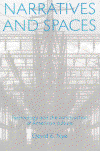 |
 |
 |
 |
![]()
Volume 4,
Issue 3, Spring 2001
|
Narratives and Spaces: Technology and the Construction of American Culture David E. NyeUniversity of Exeter Press, 1997 224 pages Hardcover: £40.00 Paperback: £14.99 |

|
Reviewed by: Joy
Hart, University
of Louisville
Printer-friendly PDF
version
David Nye's Narratives and Spaces: Technology and the Construction of American Culture has received considerable attention since its publication almost four years ago. This cultural history of the United States is the first book in the University of Exeter Press series on Representing American Culture. Through several case studies, Nye analyzes machine-driven transformations and their resulting cultural impacts - and in particular, the stories generated to legitimate these machines and associated cultural results. Seeing machines as social constructions, Nye's interest centers in examining the process by which technology is woven into cultural talk (i.e., our narratives) and how these narratives come to shape our sense of place (or cultural landscape). Nye asserts:
People use technologies to reshape and reimagine their material context, and their experience of any space is a complex, mediated encounter. Machines do not simply appear. People invent and shape them within a larger context, which includes visual practices and narrative strategies (p. 2)
One goal of Nye's volume is to debunk technological determinism. Much cultural lore accepts technology as a given and considerable media coverage suggests that technology is a change-agent. However, Nye emphasizes that "machines are not autonomous" (p. 2) - people develop and use them, whether or not such persons recognize the outcomes of this development or use. In Nye's view, narrative forms the basis of the dialogue humans have about the implementation of new and existing technologies.
An additional goal is to illustrate the relationship between technology and landscape. According to Nye though technology, landscape is created. For example, Nye asserts that through intentional (e.g., building dams) or unintentional actions (e.g., worsening erosion), humans have always altered the land and that how one sees the land is a socially-constructed process.
Toward these goals, Nye organizes the book around historical examples. The book contains a short introduction, three major sections (Spaces, Narratives, and Narratives in Space, respectively), and a brief conclusion. The first section, Spaces, contains three chapters (Niagara Falls and the Grand Canyon, the American West, and Morris's The Home Place). Examining constructions of Niagara Falls and the Grand Canyon, Nye focuses attention on how we interpret these "natural" wonders and the ways we have represented them over time based on available technology. Then, Nye addresses the role of technologies, such as the railways, in facilitating white settlement of the West and subsequent landscape shaping. Then, Nye examines a literary work for its representation of space and place.
The second section, Narratives, also contains three chapters (New Deal Electrification, Energy Narratives, and Doctorow's World's Fair). In the first two chapters, Nye addresses several narratives on the possibilities of electricity and the meanings we hold for sources of energy. As in the first section, he then deconstructs a literary piece for its relevance to narrative.
Finally, the third section, Narratives in Space, contains four chapters (Electrifying Expositions, the 1939 World's Fair, the Apollo Space Program, and Computers). Each of these cases intertwines his interest in narrative and space. First, he provides a history of illumination at the world's fairs. Second, he investigates European exhibits at the 1939 New York World's Fair. Third, he analyzes NASA's selling of space exploration. And finally, Nye explores the adoption of the computer and our embracing of cyberspace.
Through these ten case studies, Nye proves deft at analyzing the interchange between technology and culture. In these examples, we see narrative as the vehicle through which we have imagined and actualized "modernization" in the U.S. According to Nye, six "characteristic narratives" emerge from the overall set. These are: overlooking machines, presenting machines as "agents of social amelioration," technology as social control, new technology as shaping perceptions, "satiric" (linked to unpredicted impacts), and "apocalyptic" (i.e., "agents of doom"). In this vein, Nye asserts:
All of these narratives can be used to present technologies as deterministic forces, which, depending on one's assumptions, can lead to automatic growth, social betterment, massive surveillance, transformation of the life-world, ironic reversals of intended results, or apocalyptic destruction (p. 179).
However, Nye's ultimate point is that such deterministic views provide unclear and insufficient explanations. He stresses "human beings, not machines, are the agents of change, as men and women introduce new systems of machines that alter their lifeworld" (p. 180). Through examining a machine's location, use, and stories about it, we can come to understand its cultural meaning. "Theories of narrative can be used to understand such major events as electrification, the adoption of the automobile, the 1970s energy crisis, or the Apollo Space Program" (p. 180). Again refuting the idea of technological determinism, Nye concludes, "Machines do not impinge on an abstract space, after arriving from some other sphere, but rather are created and given their diverse meanings within American culture's narratives and spaces" (p. 189).
Back to Top
Home | Current
Issue | Archives | Editorial
Information | Search | Interact